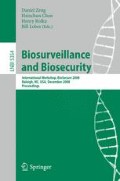Abstract
The Bayesian Aerosol Release Detector (BARD) is a biosurveillance system for detecting and characterizing disease outbreaks caused by aerosol releases of anthrax. A major challenge in modeling a population’s exposure to aerosol anthrax is to accurately estimate the exposure level of each individual. In part, this challenge stems from the fact that the only spatial information routinely contained in the biosurveillance databases is the residential administrative unit (e.g., the home zip code of each case). To deal with this problem, nearly all anthrax biosurveillance systems, including BARD, assume that exposure to anthrax would occur at one’s residential unit—a limiting assumption. We propose a refined version of BARD, called BARD-C, which incorporates the effect of commuting on a worker’s exposure. We also present an experimental study to compare the performances of BARD and BARD-C on semi-synthetic outbreaks generated with an algorithm that also accounts for commuting.
Access this chapter
Tax calculation will be finalised at checkout
Purchases are for personal use only
Preview
Unable to display preview. Download preview PDF.
References
Kaufmann, A., Meltzer, M., Schmid, G.: The economic impact of a bioterrorist attack: are prevention and postattack intervention programs justifiable? Emerging Infectious Diseases 3, 83–94 (1997)
Wagner, M.M., Tsui, F.C., Espino, J.U., Dato, V.M., Sittig, D.F., Caruana, R.A.: The emerging science of very early detection of disease outbreaks. Journal of Public Health Management Practice 7, 51–59 (2001)
Hogan, W.R., Cooper, G.F., Wallstrom, G.L., Wagner, M.M., Depinay, J.-M.: The Bayesian aerosol release detector: An algorithm for detecting and characterizing outbreaks caused by an atmospheric release of Bacillus anthracis. Statistics in Medicine 26, 5225–5252 (2007)
Buckeridge, D.L.: A method for evaluating outbreak detection in public health surveillance systems that use administrative data. PhD Thesis, Stanford University (2005)
Kleinman, K.: Generalized linear models and generalized linear mixed models for small-area surveillance. In: Lawson, A.B., Kleinman, K. (eds.) Spatial and Syndromic Surveillance for Public Health, pp. 73–90. John Wiley & Sons, Chichester (2005)
Cami, A., Wallstrom, G.L., Hogan, W.R.: Effect of commuting on the detection and characterization performance of the Bayesian aerosol release detector. In: Proc. International Workshop on Biomedical and Health Informatics, Philadelphia, PA, USA (November 2008) (to appear)
Duczmal, L., Buckeridge, D.L.: A workflow spatial scan statistic. Statistics in Medicine 25, 743–754 (2006)
Kulldorff, M.: A spatial scan statistic. Communications in Statistics: Theory and Methods 26, 1481–1496 (1997)
Garman, C., Wong, W.K., Cooper, G.F.: The effect of inferring work location from home location in performing Bayesian biosurveillance. In: The Syndromic Surveillance Conference, Seattle, Washington (2005)
Cooper, G.F., Dash, D.H., Levander, J.D., Wong, W.K., Hogan, W.R., Wagner, M.M.: Bayesian biosurveillance of disease outbreaks. In: Proc. Conference on Uncertainty in Artificial Intelligence, pp. 94–103 (2004)
Lawson, A.B., Kleinman, K.: Spatial and Syndromic Surveillance for Public Health. Wiley, Chichester (2005)
Fawcett, T., Provost, F.: Activity monitoring: noticing interesting changes in behavior. In: Proc. 5th ACM SIGKDD International Conference on Knowledge Discovery and Data Mining (KDD 1999), San Diego, California, United States, pp. 53–62. ACM Press, New York (1999)
Author information
Authors and Affiliations
Editor information
Editors and Affiliations
Rights and permissions
Copyright information
© 2008 Springer-Verlag Berlin Heidelberg
About this paper
Cite this paper
Cami, A., Wallstrom, G.L., Hogan, W.R. (2008). Integrating a Commuting Model with the Bayesian Aerosol Release Detector. In: Zeng, D., Chen, H., Rolka, H., Lober, B. (eds) Biosurveillance and Biosecurity . BioSecure 2008. Lecture Notes in Computer Science(), vol 5354. Springer, Berlin, Heidelberg. https://doi.org/10.1007/978-3-540-89746-0_9
Download citation
DOI: https://doi.org/10.1007/978-3-540-89746-0_9
Publisher Name: Springer, Berlin, Heidelberg
Print ISBN: 978-3-540-89745-3
Online ISBN: 978-3-540-89746-0
eBook Packages: Computer ScienceComputer Science (R0)

